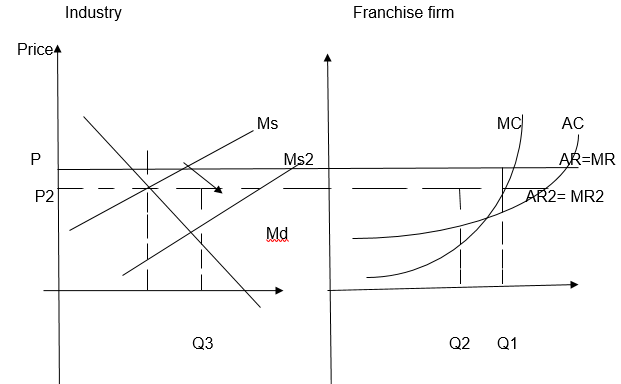Benefits of Economies of scale
A franchise firm is big company which means that their cost of every unit sold or produced is lower and this implies that they earn higher profits; thus, as the firm expands, the cost per every unit sold or produced significantly reduces (Abraham, 2007). Franchise firm benefits from the economies of scale in that production in large quantities reduce strong entry barriers if the firm is utilizing the available technology in the market. Thus, a firm minimizes its cost of production by selling its product around using the least efficient scale (Abraham, 2007).
The firm also gain huge benefits from the mass production of related products and services such as branding and development or innovation. Franchise firms do not spend a lot in advertising their products and the brand name as the franchisee stores take care of this as they are widely distributed across a wide region; thus costs is reduced on such processes (Freeadvice, 2011). The firm does not spend a lot in innovation since franchisees open similar stores of franchise firm, as directed by the franchiser. Therefore, the economies of scale take place where specific levels of costs are fixed which in this case a franchise cost are almost fixed resulting to mass production because huge quantities reduces the cost per unit (Freeadvice, 2011).
Disadvantages of being part of a large corporation
When firm becomes large in size with the intention of benefiting from the economies of scale, these benefits eventually reduces at a given point as the company continues to increase attains a specific size, resulting to diseconomies of scale. Diseconomies of scale occur when the corporation’s size becomes excessive and can be evidently seen in a LRAC curve (Abraham, 2007).
The diseconomies of scale brings with it complexity in supervision and control as the production level increases which is one of the reason that costs start to increase again; it also increases transaction costs such as transport expenses for tangible products which offsets savings earned by centralised manufacturing (Petroff, 2002).
This eventually triggers diseconomies of scale in the sense that it is only huge firms that are prone to bureaucracy which result to sluggish decision making because of its excessive administration size (Petroff, 2002). In addition the employees lose their morale leading to complicated labour relations eventually resulting to less production from the employees (Abraham, 2007).
Long-run profit in a Competitive market
In the short run the companies may be very profitable leading to increase in the quantity produced by the companies which eventually attracts new entrants into the sector; this response by companies towards a profitable industry is an indication for resources reallocation in the market and also contributes to reduced profits (Libby and Tregarthen, 2009); the addition of suppliers leads to the shifting of the supply curve to the right as shown below.
Assuming that the demand curve of the market remains constant, a high supply in the market will decrease the market price equilibrium until the market price equates to average long run cost; each company is thus earning normal profit at this particular point. Therefore, no more entry and exit in the sector is economical and the long-run equilibrium is achieved (Tutor2u.net, 2010).
The new entrants in the sector shifts the supply curve of the market to Ms2 and the price reduces to P2; at Q3, the point at which profit is maximised, the firms are just earning normal profits which results to the long-run equilibrium. Therefore, the franchise firm will make normal profits in the long-run by selling its products at price P2 and by selling a quantity amounting to Q3, this is also the point at which average revenue (AR2) of the firm equals marginal revenue (MR2) (Tutor2u.net, 2010).

References
Abraham, J. (2007). Economies Of Scale Size Matters In Business Strategy. Web.
Freeadvice.com. (2011). Franchises. Web.
Libby, R. and Tregarthen, T. (2009). Chapter 8: Production and Costs. Sections 1-4 Principles of Microeconomics. Web.
Petroff, J. (2002). Chapter 3: Production Costs. Web.
Turo2u.net. (2010). long run price and output under perfect competition. Web.